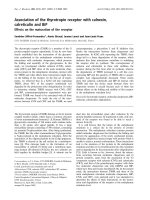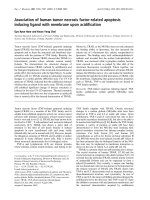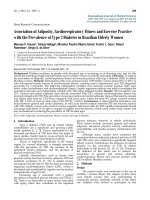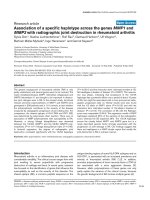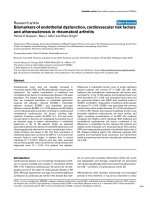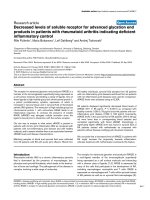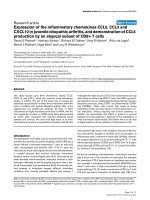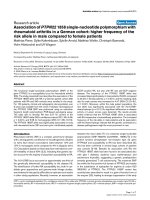Báo cáo y học: "Association of IL-4RA single nucleotide polymorphisms, HLA-DR and HLA-DQ in children with Alternaria-sensitive moderate-severe asthm" pptx
Bạn đang xem bản rút gọn của tài liệu. Xem và tải ngay bản đầy đủ của tài liệu tại đây (399.7 KB, 9 trang )
RESEARC H Open Access
Association of IL-4RA single nucleotide
polymorphisms, HLA-DR and HLA-DQ in children
with Alternaria-sensitive moderate-severe asthma
Alan P Knutsen
1,3*
, Hari M Vijay
5
, Barbara Kariuki
1,3
, Luis A Santiago
2
, Ralph Graff
2
, Jonathan D Wofford
1
,
Maulik R Shah
1,4
Abstract
Background: Asthma afflicts 6% to 8% of the United States population, and severe asthma represents
approximately 10% of asthma tic patients. Several epidemiologic studies in the United States and Europe have
linked Alternaria sensitivity to both persistence and severity of asthma. In order to begin to understand genetic risk
factors underlying Alternaria sensitivity and asthma, in these studies we examined T cell responses to Alternaria
antigens, HLA Class II restriction and HLA-DQ protection in children with severe asthma.
Methods: Sixty children with Alternaria-sensitive moderate-severe asthma were compared to 49 childr en with
Alternaria-sensitive mild asthma. We examined HLA-DR and HLA-DQ frequencies in Alternaria-sensitive asthmatic by
HLA typing. To determine ratios of Th1/Th2 Alternaria-specific T-cells, cultures were stimulated in media alone,
Alternaria alternata extract and Alt a1. Sensitivity to IL-4 stimulation was measured by up-regulation of CD23 on
B cells.
Results: Children with Alternaria-sensitive moderate-severe asthma trended to have increased sensitivities to
Cladosporium (46% versus 35% ), to Aspergillus (43% versus 28%), and significantly increased sensitivities to trees
(78% versus 57%) and to weeds (68% versus 48%). The IL-4RA ile75val polymorphism was significantly increased in
Alternaria-sensitive moderate-severe asthmatics, 83% (0.627 allele frequency) compared to Alternaria-sen sitive mild
asthmatics, 57% (0.388 allele frequency). This was associated with increased sensitivity to IL-4 stimulation measured
by significantly increased IL-4 stimulated CD23 expression on CD19+ and CD86+CD19+ B cells of Alternaria-
sensitive moderate-severe asthmatics. IL-5 and IL-13 synthesis was significantly increased in Alternaria-sensitive
moderate-severe asthmatics compared to mild ast hmatics to Alternaria extract and Alt a1 stimulation. The
frequency of HLA-DQB1*03 allele was significantly decreased in Alternaria-sensitive moderate-severe asthmatics
compared to mild asthmatics, 39% versus 63%, with significantly decreased allele frequency, 0.220 versus 0.398.
Summary: In children with Alternaria-sensitive moderate severe asthma, there was an increased Th2 response to
Alternaria stimulation and increased sensitivity to IL-4 stimulation. This skewing towards a Th2 response was
associated with an increased frequency of the IL-4RA ile75val polymorphism. In evaluating the HLA association,
there was a decreased frequency of HLA-DQB1*03 in Alternaria-sensitive moderate severe asthmatic children
consistent with previous studies suggest that HLA-DQB1*03 may be protective against the development of mold-
sensitive severe asthma.
* Correspondence:
1
Department of Pediatrics, Saint Louis University, St Louis, Missouri, 63104,
USA
Knutsen et al. Clinical and Molecular Allergy 2010, 8:5
/>CMA
© 2010 Knutsen et al; licensee BioMed Central Ltd. This is an O pen Access ar ticle distributed und er the terms of the Creative Commons
Attribution License (http: //creativecommons.org/licenses/by/2.0), which permits unrestricted use, distribution, and reproduction in
any medium, provided the original work is properly cited.
Background
Asthma afflicts 6% to 8% of the United States population,
and severe asthma represents approximately 10% of asth-
matic patients [1]. This subset of severe asthmatic
patients have significant morbidity and utilize health care
resources disproportionately more compared to asth-
matic patients with less severe disease. The current medi-
cation regimen of inhaled corticosteroids, leukotriene
antagonists, and long-acting beta-2 agonists are usually
inadequate to control severe asthma. Thus, it becomes
important to understand the mechanism(s) as to why
these patients have pulmonary inflammation that is not
adequately controlled by current treatment regimens.
Several epidemiologic studies in the United States and
Europ e have linked Alternaria sensitivity to both persis-
tence and severity of asthma [2-18]. Alternaria alternata
spores are the most common airborne mold in th e Uni-
ted States and are especially prevalent in the grain-grow-
ing areas of the Midwest. In addition, significant risk for
acute asthma and life-threatening asthma has been asso-
ciated with Alternaria-sensitive asthma when mold
spore counts have been elevated [19-23]. Recently, Pas-
qualotto et al [24] coined the term severe asthma asso-
ciated with fungal sensitization (SAFS) in adult patients
with asthma in the United Kingdom. In their studies,
sensitivity to Aspergillus fumigatus was the most preva-
lent (66%), followed by sensitivities to Cladosporium
(52%) a nd to Alternaria (34%). Furthermore, treatment
of these patients w ith itraconazole in a 32 week trial
resulted in improved asthma quality of life (AQLQ),
decreased IgE levels, and increased peak flow (PF).
The imm unopathogenesis of atopic asthma is complex
and multifunctional. Multiple genetic risk factors invol-
ving the inflammatory pathways, including poly morph-
isms of IL-4RA , IL-4, IL-10, IL-13,andCD14, have been
described but are not present in the majority of patients.
In particular, polymorphisms of IL-4RA and IL-13 have
been associated with elevated IgE levels and asthma
severity. We hypothesized tha t there are genotype simi-
larities between Alternaria-sensitive moderate-severe
asthma and allergic bronchopulmonary aspergillosis
(ABPA). In our studies of ABPA, we identifi ed genetic
factors for the development of ABPA: (1) HLA-DR2 and
HLA-DR5 restriction [25-27], and (2) IL-4RA single
nucleotide polymorphism (SNP)[27,28]. Interestingly,
thepresenceofHLA-DQ2eveninthepresenceof
HLA-DR2/DR5 contributed to resistance of the develop-
ment of ABPA. ABPA is a Th2 allergic hypersensitivity
lung disease due to bronchial colonization of A. fumiga-
tus that affects 1-2% of asthmatic and 7-9% of cystic
fibrosis (CF) patients. Acute flares of ABPA are charac-
terized by wheezing, pulmonary infiltrates, eosinophilia,
increased levels of total IgE, and increased levels of anti-
A. fumigatus specific IgE, IgG and IgA antibody levels.
In the present study, we examined HLA class II antigens
and IL-4RA polymorphisms in Alternaria -sensitive mod-
erate severe asthmatic children.
Methods
Study Population and Sample Size
The study population consisted of both male and female
Caucasian, African-American, Hispanic children 5 to 18
years old with mild, moderate, and severe persistent
asthma recruited from the Allergy and Asthma clinics at
Cardinal Glennon Children’ s Medical Center, Saint
Louis University. Children were not stratified or
excluded by race of gender. Classification of asthma
severity was the GINA (NHBLI) criteria using day/night
symptoms, pulmonary function, and medications.
Patients were evaluated for allergen sensitivities by
allergy prick skin testing (Multi-Test II; Lincoln Diag-
nostics, Decatur, IL) to Alternaria alternata, Clados por-
ium herbarum, Helmi nthosporium sativum, Aspergillus
fumigatus, Dermatophagoides pteronyssinus and farinae
(housedust mites, HDM), American/German cockroach,
cat hair, dog epithelium, tree pollens (oak, hickory-
pecan, maple/box elder, elm, ash, sycamore, walnut,
juniper, birch), grass po llens (Johnson, B ermuda, June,
timothy, bahia), and weed pollens (short and giant rag-
weed, plantain, sorrel, mugwort, hackberry, mulberry)
(reagents obtained from Greer Laboratories, Lenoir,
NC). Tests were regarded as positive when the mean
diameter of the wheal was ≥ 3mm.Thestudygroup
consisted of Alternaria-sensitive moderate-severe
asthma compared to Alternaria-sensitive mild asth-
matics. The study was fully approved by the Saint Louis
University Institutional Review Board (IRB #14611,
approved 9-3-2008).
IL-4RA genotyping by direct sequence analysis
IL-4RA polymorphisms were detected as previously
described [27,28]. Genomic variants of IL-4RA were
numbered on the basis of their location in IL-4RA
mRNA sequence of gene bank accession number
X52425. Five previously reported IL-4RA variants ile75-
val (rs1805010), glu400ala (rs1805011), cys431arg
(rs1805012), ser503pro (rs1805015) and gln576arg
(rs1801275)(numbering including the 25 amino acid sig-
nal peptide) were genotyped. Genomic variants in IL-
4RA were identified by direct sequencing in both the
forward and reverse direction. Both forward and reverse
sequencing primers were used to maintain quality con-
trol. Primer sequences and conditions are available upon
request. The presence of IL-4RA nucleotide polymorph-
isms was examined using the NCBI Blast program
( accession
Knutsen et al. Clinical and Molecular Allergy 2010, 8:5
/>Page 2 of 9
number 33833); homozygous/heterozygous SNPs were
detected on the nucleotide chromatograph.
IL-13 genotyping by PCR restriction fragment length
polymorphism analysis
Genotyping was performed by PCR amplification of the
genomic DNA region containing the arg110 gln SNP
(rs20541) followed by restriction digestion and compari-
son of size fragments to a standard size DNA ladder on
gel electrophoresis, as previously described [27,28]. The
expected product sizes are 236 bp for the wild type
sequence and 178 bp for the arg110gln SNP. Complete
digestion is c onfirmed by the presence of a 26 bp frag-
ment from the NLAIV site in the primer and in the 5’
end of the PCR product. Detailed PCR conditions are
available upon request.
IL-4 induction of B-cell CD23 expression
Peripheral blood mononuclear cells (PBMC) were iso-
lated from venous blood by Ficoll-Hypaque density cen-
trifugation as previously described [28]. PBMC were
cultured at 1 × 10
6
cells/ml in 1 ml of RPMI 1640 sup-
plemented with 10% FCS for 48 hours at 37°C in a 6%
CO
2
humidified atmosphere. The cultures were stimu-
lated with rhuIL-4 (PeproTech, Inc) at 25 ng/ml. After
48 hours, the cells were washed and a nalyzed by flow
cytometry.
Flow cytometry
PBMC prior to culture and after culture were analyzed
for induction of cell surface CD23 expression on B-cells,
as previously described [27,28]. For cultures stimulated
with IL-4, PBMC were washed and stained with murine
monoclonal antibody to CD23-PE and CD20 Per-CP
(Becton Dickinson). PBMCs were washed and fixed with
1% PBS buffered paraformaldehyde. Forward an d side-
scatter was performed to gate on the live lymphocyte
population and further gated on CD20
+
cells for analysis
using the CellQuest program (Becton Dickinson). A
minimum of 10,000 cells were counted. Quantibrite PE
flow cytometry beads (Becton Dickinson) were used to
quantify the number of CD23 receptors per B-cell for
each experiment. The beads contain a given number of
PE molecules per bead. A linear equation was calculated
from which the number of CD23 receptors per cell was
extrapolated, and the total number of CD23 receptors
expressed per B-cell determined.
TH1/Th2 cytokines and chemokines
To determine Th1/Th2 Alternaria-specific T-cell
response, Alternaria stimulated cultures were performed
as previously described [27,28]. 1 × 10
6
PBL were cul-
tured in 1 ml volume of RPMI supplemental with 10%
FCS for 1 week in a humidified 5% CO
2
atmosphere at
37°C. Cultures were stimulated in media alone , 25 mcg/
ml of Alternaria alternata extract and 25 mcg/ml of Alt
a1. The culture supernatant were obtained and frozen at
-70°C until analyzed . Alternaria extract and Alt a1 were
obtained from Dr. Hari Vijay. Measurement of Th1/Th2
culture supernatant cytokines and chemokines was per-
formed by Flex Cytometric Bead Assay (BD Pharmin-
gen) to measure IL-4, IL-5, IL-10, IL-13, IFN-g,
synthesis, as previously described [27,28].
HLA typing
In o rder to examine HLA-DR and HLA-DQ allelic fre-
quencies in Alternaria-sensitive asthmatic, HLA-DR and
DQ typing was performed in the HLA Laboratory as
previously described [25-27]. HLA-DRB1 alleles were
detected by PCR amplification of genomic DNA with
sequence specific primers (PCR-SSP; Dynal, Inc, Oslo,
Norway). HLA-DQ typing were performed by PCR
amplification of genomic DNA b y using low resolution
HLA-DQB allele specific primers identifying 5 HLA-DQ
alleles (One Lambda, Canoga, Park, CA).
Statistical analysis
The data for PFTs and cytokine levels were expressed as
the mean ± SD and for IgE geometric mean ×/÷ SD.
Statistical analysis using two-tailed Mann-Whitney U
test was used comparing mold-sensitive moderate-severe
asthma to other groups. Two-sided Fisher’sexacttest
analysis was used comparing moderate-severe asthma to
mild asthma. P values less than 0.05 were considered
significant, using GraphPad InStat software package.
Results
Demographics
In Table 1, the demographics of Alternaria-sensitive
moderate-sev ere asthma is com pared to Alternaria-sen-
sitive mild asthma in children. Comparison of Alter-
naria-sensitive moderate-severe asthmatics to
Alternaria-sensitive mild asthmatics demo nstrated that
the groups were age and sex matched comparably.
However, there were significantly greate r percentage of
African-Americans in the Alternaria-sensitive moderate-
severe asthma group compared to the Alternaria-sensi-
tive mild asthma group, 70% versus 36% (p = 0.0002).
Medication u se of omalizumab (p < 0.0001), high-dose
and medium-dose inhaled corticosteroids (p < 0.0001
and p = < 0.0002, respectively), long-acting beta agonists
(p < 0.0001) was significantly increased in Alternaria-
sensitiv e moderate severe asthmatics co mpared to Alter-
naria-sensitive mild asthmatics. Immunotherapy was
part of the treatment in 4% of Alternaria-sensitive mod-
erate-severe asthmatics and 5% of Alternaria-sensitive
mild asthmatics. The percentage of patients on immu-
notherapy is unlikely to affect the responses to
Knutsen et al. Clinical and Molecular Allergy 2010, 8:5
/>Page 3 of 9
Alternaria stimulation. Results of pulmonary function
studies performed on current medications revealed that
FVC, FEV-1, FEF-25-75, and FEV-1/FVC ratio were sig-
nificantly decreased in Alternaria-sensitive moderate-
severe asthma compared to Alternaria-sensitive mild
asthma. Total serum IgE levels were significantly
increased in Alternaria-sensitive moderate-severe
asthma compared to Alternaria-sensitive mild asthma,
469 IU/ml versus 140 IU/ml (p < 0.0001). Children with
Alternaria-sensitive moderate-severe asthma t ended to
have increased sensitivities to Cladosporium and Asper-
gillus as well. Alternaria-sensitive moderate-severe
asthma had increased sensitivities to tree pollens (78%
versus 57%, p = 0.01) and to weed pollens ( 68% versus
48%, p = 0.04).
IL-4RA and IL-13 polymorphisms
The results of IL-4RA single nucleotide polymorp hisms
(SNP) a re seen in Table 2. The presence a nd allele fre-
quency of IL-4RA ile75val SNP were significantly
increased in Alternaria-sensitive moderate-severe asth-
matics compared to Alternaria-sensitive mild asth-
matics, 83% of patients versus 57% of patients
(p = 0.005) and allele frequency 0.627 versus 0.388
(p = 0.012). This is similar t o our studies in ABPA,
where the frequency of IL-4RA ile75val was significantly
increased compared to Aspergillus-sensitive asthmatics
and CF patients. Other IL-4RA SNPS, glu400ala, ser503-
pro, and gln576arg tended to be increased frequency in
Alternaria-sensitive asthmatics but were not statistically
significant. However, the combination of 75val and
576arg, 75val576arg IL-4RA, was significantly increased
in Alternaria- sensitiv e moderate-severe asthmatics, 63%
versus 38% (p = 0.012). The IL-13 arg110gln SNP was
similar in both moderate-severe and mild asthmatics,
31% versus 37%, with similar allele frequencies, 0.178
versus 0.204 . The combination of the IL-4RA and IL-13
SNPs, 75val/576arg/110gln, was te nded to be increased
in Alternaria- sensitiv e moderate-severe asthmatics, 22%
versus 8% (p = 0.07).
Up-regulation of CD23 expression
The up-regulation of CD23 molecules on B-cells by IL-4
stimulation is shown in Figure 1. In the absence of IL-4,
Table 1 Demographics of children with Alternaria-
sensitive moderate-severe asthma compared to
Alternaria-sensitive mild asthma
Study Moderate-Severe
(60)
Mild
(49)
P
Age, years 11 ± 4 10 ± 3
Sex, % male/female 62/38 64/36
White/Black/Hispanic, %
#
30/70/0 57/36/7 0.0002
Atopic dermatitis, % 33 26
Medications, %
#
Omalizumab 28 0 <0.0001
ICS-H 36 4 <0.0001
ICS-M 52 18 0.0002
ICS-L 10 62 <0.0001
LABA 84 40 <0.0001
LTRA 77 64
Immunotherapy, % 4 5
Pulmonary function*
FVC 88 ± 15 98 ± 11 <0.0001
FEV-1 78 ± 16 94 ± 11 <0.0001
FEF-25-75 64 ± 23 88 ± 23 <0.0001
FEV-1/FVC 85 ± 12 93 ± 8 <0.0001
IgE, IU/ml* 469 ×/÷ 3.51 140 ×/÷ 5.01 0.0001
Sensitivites, %
#
Alternaria 100 100
Cladosporium 46 35
Helminthosporium 32 28
Aspergillus 43 28
Der p and/or Der f 52 37
Cat 46 28
CR 28 22
Trees 78 57 0.01
Grasses 56 54
Weeds 68 48 0.04
Abbreviations: ICS-H, inhaled corticosteroid-high dose; ICS-M, -medium dose;
ICS-L, -low dose; LABA, long-acting beta agonist; LTRA, leukotriene antagonist;
IT, immunotherapy; FVC, forced vital capacity; FEV-1, forced expiratory volume
1 second; FEF, forced expiratory flow; CR, cockroach.
Pulmonary Function data expressed presented as Mean ± SD; IgE data
expressed as Geometric Mean×/÷SD; Sensitivities data expressed as
percentage of patients.
P value using Mann-Whitney U test* and Fisher’s exact test
#
.
Table 2 IL-4RA and IL-13 polymorphisms in children with
Alternaria-sensitive moderate-severe asthma compared
to Alternaria-sensitive mild asthma
Study Moderate-Severe
(60)
Mild
(49)
P
IL-4RA SNPs
ile75val 83 (0.627) 57 (0.388) 0.005 (0.012)
glu400ala 61 (0.390) 49 (0.265)
cys431arg 15 (0.102) 22 (0.112)
ser503pro 53 (0.347) 37 (0.214)
gln576arg 75 (0.534) 59 (0.406)
IL-13 SNP
arg110gln 31 (0.178) 37 (0.204)
75val/576arg 63 38 0.012
75val/110gln 31 17
75val/576arg/110gln 22 8 0.07
Abbreviations: IL-4RA, IL-4 receptor alpha chain; SNP single nucleotide
polymorphisms.
Data presented as percentage (%) of patients and in parentheses, allele
frequency.
P value using Fisher’s exact test.
Knutsen et al. Clinical and Molecular Allergy 2010, 8:5
/>Page 4 of 9
the number of CD23 molecules decreased after 48 hours
in media and was comparable in b oth Alternaria-sensi-
tive moderate-severe and mild asthmatics. With IL-4 sti-
mulation, the number of CD23 molecules per CD19+
and CD19+CD8 6+ B cell were signi ficantly increased in
Alternaria-sensitive moderate-severe asthmatics com-
pared t o Alternaria-sensitive mild asthmatics (p < 0.04
and p, 0.04, respectively).
Cytokine synthesis
In Alternaria-sensitive moderate-severe asthma, Alter-
naria extract stimulated lymphocytes had significantly
increased synthesis of IL-5 and IL-13 compared to
Alternaria-sensitive mild asthma (p = 0.008 and
p = 0.00 4, respectively) (Figure 2). Similarly, IL-5 and
IL-13 synthesis was increased to Alt a1 stimulated lym-
phocytes in Alternaria-sensitive moderate-severe asth-
matics compared to Alternaria-sensitive mild asthmatics
(p = 0.07 and p = 0.007, respectively). This would sug-
gests that in Alternaria-sensitive moderate-severe
asthma Alternaria exposure results in increased Th2
allergic inflammatory responses compared to Alternaria -
sensitive mild asthma. Asp f1 and Der p1 stimulated
IL-5 and IL-13 synthesis tended to be increased in
Figure 1 Up-regulation of CD23 molecules by IL-4 stimulation on B cells. Following IL-4 stimulation, Alternaria-sensitive moderate-severe
asthmatics had a significantly increased CD23+ expression on both CD19+ and CD19+CD86+ B-cells compared to Alternaria-sensitive mild
asthmatics (p < 0.04 and p < 0.04, respectively, Mann-Whitney U test). Data presented as Mean ± SD.
Figure 2 Alternaria-stimulated cytokine synthesis in Alternaria-sensitive moderate-severe asthma. IL-5 and IL-13 synthesis was significantly
increased in Alternaria extract stimulated T cells by Alternaria-sensitive moderate-severe asthmatic patients compared to Alternaria-sensitive mild
asthma (p = 0.008 and p = 0.004, respectively) and to Alt a1 stimulated T cells by Alternaria-sensitive moderate-severe asthmatic patients
compared to Alternaria-sensitive mild asthma (p = 0.07 and p = 0.007, respectively). In Asp f3 and Der p stimulated cultures, there were no
significant differences of IL-5 and IL-13 synthesis comparing Alternaria-sensitive moderate-severe asthmatic versus Alternaria-sensitive mild
asthmatics. Data presented as Mean ± SD. P value using Mann-Whitney U test.
Knutsen et al. Clinical and Molecular Allergy 2010, 8:5
/>Page 5 of 9
Alternaria-sensitive moderate-severe asthmatics com-
pared to Alternaria-sensitive asthmatics but was not sig-
nificant (data not shown). This suggested that the
increased Th2 cytokine s ynthesis was specific to Alter-
naria stimulation.
HLA-DR and HLA-DQ typing
We subsequently examined frequencies of HLA-DR
HLA-DP, and HLA-DQ in Alterna ria-sensitive moder-
ate-severe asthmatics (Table 3). The frequencies of HLA-
DP were not significantly different comparing the groups
(data not shown). The HLA-DQB1*03 allele was signifi-
cantly decreased in Alternaria-sensitive moderate-severe
asthmatics compared to Alternaria -sensitive mild asth-
matics, 39% versus 63% (p = 0.02), with significantly
decreased allele frequency, 0.220 versus 0.398 (p =
0.007). In previous studies, Chauhan et al (32) reported
that HLA-DQB1*03 was present in 51% of 98 non-atopic
controls, and in the dbMHC data base i.
nlm.nih.gov/projects/mhc/ihwg.cgi theHLA-DQB1*03
allele frequency was significantly increased in 78.5% of
1328 individuals in North America (p < 0.0001). Our
results suggest a significant stratification compared to the
background population frequencies. These preliminary
results of decreased frequency of HLA-DQB1*03 in
Alternaria-sensitive moderate-severe asthma in children
is similar to that found in ABPA where HLA-DQB1*02
was decreased. It was determined that HLA-DQB1*02
was protective against the development of ABPA in
Aspergillus-sensitive asthmatics and CF patients. These
preliminary results of decreased frequency of HLA-
DQB1*03 in Alternaria-sensitive moderate-severe asth-
matics will need to be confirmed with a larger study
population.
TheallelefrequencyofHLA-DRB1*13tendedtobe
increased in Alternaria-sensitive moderate-severe
asthma compared to Alternaria-sensitive mild asthma,
37% versus 20% (p = 0.06). The frequency of HLA-
DRB1*13 in Alternaria-sensitive moderate-severe asthma
was significantly increased compared to individuals in
the dbMHC data base http://ww w.ncbi.nlm.nih.gov/pro-
jects/mhc/ihwg.cgi, HLA-DRB1*13 ranged from 0.5% of
1330 individuals in North America to 9.8% of 2587 indi-
viduals in Europe (p < 0.0001).
Discussion
Alternaria alternata spores are the most common air-
borne mold in the United States and are especially preva-
lent in the grain-gro wing areas of the Midwest. Several
epidemiologic studies in the United States and Europe
have linked Alternaria sensitivity to both persistence and
severity of asthma [2-18]. Many Alternaria allergens have
been isolated and purified. Similar to Aspergillus allergens,
these proteins have biologic activity on t he respiratory
epithelia in addition to inducing allergic inflammatory
responses. Kauffman et al [29] reported that Alter naria
and Cladosporium proteases had a direct effect on the
bronchial epithelia causing pro-inflammatory cytokine
synthesis and desquamation similar to A. fumigatus pro-
teases; a lthough Aspergillus proteases were more potent.
In addition, Kheradmand et al [30] in a murine model
demonstrated that Alternaria proteases promoted a
chronic eosinophilic inflammation in the airways of mice
exposed to these antigens. Thi s is similar to the findings
that Kurup’s group identified in their m urine model of
allergic bronchopulmonary aspergillosis (ABPA). Another
mechanism that may be operative in mold-induced asthma
involves chitin, a major structural protein of the outer
coating of fungi [31]. Chitin polarizes immune Th1
responses by suppressing Th2 responses. In humans,
acidic mammalian chitinase degrades chitin shifting the
responses toward a Th2 inflammatory response. Elevated
chitinase has been associated with asthma and elevate d
IgE levels perhaps through an IL-13 pathway [32]. In
the present studies, Alternaria-stimulated IL-5 and
IL-13 synthesis was significantly increased in Alternaria
-sensitive moderate-severe asthmatic children compared
to Alternaria-sensitive mild asthmatics. Thus, increased
Table 3 HLA-DR and HLA-DQ allele frequencies in
children with Alternaria-sensitive moderate-severe
asthma compared to Alternaria-sensitive mild asthma
Study Moderate-Severe
(60)
Mild
(49)
P
HLA-DRB1
*01 10 (0.051) 8 (0.041)
*03 29 (0.153) 20 (0.102)
*04 14 (0.076) 29 (0.153)
*07 24 (0.127) 27 (0.143)
*08 7 (0.034) 10 (0.061)
*09 7 (0.034) 4 (0.020)
*10 2 (0.008) 2 (0.010)
*11 17 (0.093) 33 (0.184)
*12 7 (0.034) 2 (0.010)
*13 37 (0.195) 20 (0.112) 0.06
*14 3 (0.017) 2 (0.010)
*15 27 (0.161) 27 (0.143)
*16 3 (0.010) 2 (0.010)
HLA-DQB1
*02 42 (0.254) 33 (0184)
*03 39 (0.220) 63 (0.398) 0.02 (0.007)
*04 12 (0.068) 8 (0.041)
*05 31 (0.161) 20 (0.102)
*06 44 (0.288) 51 (0.276)
Data presented as percentage of patients with allele and in parentheses allele
frequency.
P value using Fisher’s exact test.
Knutsen et al. Clinical and Molecular Allergy 2010, 8:5
/>Page 6 of 9
Th2 responses to Alternaria in mold-sensitive moderate-
severe asthmatic children appear to be important.
The imm unopathogenesis of atopic asthma is complex
and multifactorial. Allergic inflammation of the bron-
chial airways highlights the pathogenesis. Multiple
genetic risk factors involving the inflammatory path-
ways, including polymorphisms of IL-4RA, IL-4, IL-10,
IL-13, CD14, have been described but are not present in
the majority of patients. We hypothesized that t here are
similarities of Alte rnaria-sensitive moderate-severe
asthma and allergic bronchopulmonary aspergillosis
(ABPA). In our studies of ABPA, we identified risk fac-
tors for the development of ABPA: (1) HLA-DR2 and
HLA-DR5 restriction [25,26] and (2) IL-4RA single
nucleotide polymorphism (SNP)[27,28].
Polymorphisms of the IL-4 receptor alpha chain
(IL-4RA)andIL-13 have been associated with elevated
IgE levels and asthma severity. There are eight naturally
occurring single nucleotide pol ymorphisms (SNPs) of
the IL4RA gene: ile75val, glu400ala, cys431arg, ser436-
leu, ser503pro, gln576arg, ser752ala, and ser786pro
reported [33-38]. Studies have identified a number of
these SNPs to be associated with atopy prevalence and
asthma severity [33-38]. In the present study, IL-4RA
ile75val was significantly increased in Alternaria-sensi-
tive moderate-severe asthmatic children. Hershey et al
[33] initially reported on a high prevalence of atopy and
a gain-of-function in the IL-4R as measured by
increased CD23 expression in patients with 576arg. This
was also observed i n the present study in children with
Alternaria-sensitive moderate-severe asthma. Specifi-
cally, IL-4 stimulated CD23 up-regul ation was ob served
on CD86+ B cells. CD86+ B cells are the subpopulation
of B cells that secrete IgE, which correlates with the
increased serum IgE seen in the patients with Alter-
naria-sensitive moderate-severe asthma. A subsequent
study from Hershey ’s group found that the presence of
these two variants (75val and 576arg) together resulted
in elevated IL- 4 dependent CD23 expression which was
not observed when these SNPs were presen t al one [39].
Vladich et al (40) and Chen et al [41] reported that IL-
13 arg110gln was associated with elevated I gE levels
and increased severity of asthma [40,41]. This SNP has
an allele frequency of approxi mately 20% in the Cauca-
sian population. The IL-13 110gln polymorphism is sig-
nificantlymoreactivethanthewildtypeIL-13in
stimulating STAT-6 phosphorylation, CD23 up-regula-
tion, and IgE synthesis. Chen et al [41] also reported
that combination of the IL-4RA SNPs, 75val and 576arg,
and IL-13 SNP, 110gln, have been associated with atopy
and asthma. This was observed in 22% of the children
with Alternaria-sensitive moderate-severe asthma com-
pared to 8% of children with mild asthma. In a ddition,
Wenzel et al (1) reported that there was increased fre-
quency of the ser503pro IL-4RA polymorphism in
adults with severe asthma, which was not seen in this
study.
In ABPA, we previously r eported HLA-DR2 (HLA-
DRB1*15 and B1*16)/DR5 (HLA-DRB1*11 and HLA-
DRB1*12) restriction, and in particular HLA-DRB1*1501
and HLA-DRB1*1503 genotypes as a risk factor for the
development of ABPA [25,26]. Int erestingly, the pre-
senceofHLA-DQ2eveninthepresenceofHLA-DR2/
DR5 contributed to resistance of the development of
ABPA. In previous studies, we have identified HLA-DR
restriction to Altern aria allergens in the development of
Alternaria-sensitive m oderate-severe asthma data not
shown). In addition, HLA-DRB1*03 was significantly
increased in mold sensitive moderate-severe asthmatic
children compared to mold sensitive mild asthma tics. In
Alternaria-sensitive moderate-severe asthmatic children
the frequency of HLA-DRB1*03 trended to be increased
but was not significant. However, HLA-DQB1*03 was
significantly decreased in Alternaria-sensitive moderate-
severe asthmatics. In previous studies, HLA-DQB1*03
was demonstrated to be associated with decreased Alter-
naria stimulated IL-5 and IL-13 synthesis. Thus,
HLA-DQ3+ appears to be protective of development of
Alternaria-sensitive severe asthma.
Conclusions
In summary, we hypothesize that in children with Alter-
naria-sensitive moderate-severe asthma that there are
genetic risk factors similar to those identified in ABPA.
These include HLA-DR restriction, HLA-DQB1*03 pro-
tection, and IL-4RA polymorphisms. We propose that
there is increased sensitivity to IL-4 and IL -13 mediated
activities secondary to polymorphisms of IL-4RA. This is
associated with HLA-DRB1*03 restriction and decreased
HLA-DQB1*03 protection to Alternaria antigens that
results in Alternaria stimulated skewing of Alternaria
-specific Th2 cells, increased B-cell activity, and
increased bronchial epithelial allergic inflammatory
responses.
Key words and Abbreviations
Asthma
Alternaria alternata
HLA class II antigens
Th2 cytokines
SNP: single nucleotide polymorphism; IL-4RA: inter-
leukin 4 receptor alpha chain.
Acknowledgements
The authors appreciate the willing participation of the patients who
participated in this study. The study was partially funded by a grant from
Knutsen et al. Clinical and Molecular Allergy 2010, 8:5
/>Page 7 of 9
Genentech/Novartis CIGE025A US 32T. The author (APK) appreciates the
helpful comments and critique of Dr. Raymond G. Slavin.
Author details
1
Department of Pediatrics, Saint Louis University, St Louis, Missouri, 63104,
USA.
2
Department of Surgery, (HLA Laboratory) Saint Louis University, St
Louis, Missouri, 63104, USA.
3
Divisions of Allergy & Immunology, Saint Louis
University, St Louis, Missouri, 63104, USA.
4
Department of Genetics, Saint
Louis University, St Louis, Missouri, 63104, USA.
5
Health Canada, Healthy
Environments and Consumer Safety Branch, Hazard Identification Division,
Ottawa, ON, K1A 0K9, Canada.
Authors’ contributions
APK conceived of the study and participated in its design and coordination.
HMV provided Alternaria extract and recombinant Alt a1. BK performed cell
cultures and PCR studies. LAS performed HLA studies. RG provided expertise
in HLA studies. JDW provided statistical support. MRS provided technical
expertise in PCR studies. All authors read and approved the final manuscript.
Competing interests
The authors declare that they have no competing interests.
Received: 2 January 2010 Accepted: 18 March 2010
Published: 18 March 2010
References
1. Wenzel SE, Busse WW, National Heart, Lung, and Blood Institute’s Severe
Asthma Research Program: Severe asthma: lessons from the severe
asthma research program. J Allergy Clin Immunology 2007, 119:12-21.
2. Denning DW, O’Driscoll BR, Hogaboam CM, Bowyer P, Niven RM: The link
between fungi and severe asthma: a summary of the evidence. Eur
Respir J 2006, 27:615-626.
3. Bush RK, Prochnau JJ: Alternaria-induced asthma. J Allergy Clin Immunol
2004, 113:227-234.
4. Cantani A, Ciaschi V: Epidemiologogy of alternaria alternate allergy: a
prospective study in 6840 Italian asthmatic children. Eur Rev Med
Pharmacol Sci 2004, 8:289-294.
5. Neukirch C, Henry C, Leynaert B, Liard R, Bousquet J, Neukirch F: Is
sensitization to Alternaria alternata a risk factor for severe asthma? A
population-based study. J Clin Allergy Immunol 1999, 103:709-711.
6. Zuereik M, Neukirch C, Leynaert B, Liard R, Bousquet J, Neukirch F,
European Community Respiratory Health Survey: Sensitization to airborne
moulds and severity of asthma: cross-sectional study fro European
Community respiratory health survey. BMJ 2002, 325:411-414.
7. O’Driscoll BR, Hopkinson LC, Denning DW: Mold sensitization is common
amongst patients with severe asthma requiring multiple hospital
admissions. BMC Pulm Med 2005, 5:4.
8. Nolles G, Hoekstra MO, Schouten JP, Gerritsen J, Kauffman HF: Prevalence
of immunoglobulin E for fungi in atopic children. Clin Exp Allergy 2001,
31:1564-1570.
9. Stark PC, Burge HA, Ryan LM, Milton DK, Gold DR: Fungal levels in the
home and lower respiratory tract illnesses in the first year of life. Am J
Respir Crit Med 2003, 168:232-237.
10. Halonen M, Stern DA, Lohman C, Wright AL, Brown MA, Martinez FD: Two
subphenotypes of childhood asthma that differ in maternal and
paternal influences of asthma risk. Am J Respir Crit Care Med 1999,
160:564-570.
11. Downs SH, Mitakakis TZ, Marks GB, Car NG, Belousova EG, Leuppi JD:
Clinical importance of Alternaria exposure in children. Am J Respir Crit
Care Med 2001, 164:455-459.
12. Delfino RJ, Zeiger RS, Seltzer JM, Street DH, Matteucci RM, Anderson PR,
Koutrakis P: The effect of outdoor fungal spore concentrations on daily
asthma severity. Environ Health Perspect 1997, 05:622-635.
13. Nelson HS, Szefler SJ, Jacobs J, Huss K, Shapiro G, Sternberg AL: The
relationships among environmental allergen sensitization, allergen
exposure, pulmonary function, and bronchial hyperresponsiveness in
the Childhood Asthma Management Program. J Allergy Clin Immunol
1999, 104:775-785.
14. Perzanowski MS, Sporik R, Squillace SP, Gelber LE, Call R, Carter M, Platts-
Mills TA: Association of sensitization to Alternaria allergens with asthma
among school-age children. J Allergy Clin Immunol 1998, 101:626-632.
15. Peat JK, Tovey E, Mellis CM, Leeder SR, Woolcock AJ: Importance of house
dust mite and Alternaria allergens in childhood asthma: an
epidemiological study in two climatic regions of Australia. Clin Exp Allergy
1993, 23:812-820.
16. Halonen M, Stern DA, Wright AL, Taussig LM, Martinez FD: Alternaria as a
major allergen for asthma in children raised in a desert environment.
Am J Respir Crit Care Med 1997, 155:1356-1361.
17. Dales RE, Cakmak S, Burnett RT, Judek S, Coates F, Brook JR: Influence of
ambient fungal spores on emergency visits for asthma to a regional
children’s hospital. Am J Respir Crit Care Med 2000, 162:2087-2090.
18. Martinez FD: Progression of asthma from childhood to adolescence. Eur
Respir Rev 1997, 40:8-10.
19. Targonski PV, Persky WW, Ramekrishan V: Effect of environmental molds
on risk of death from asthma during the pollen season. J Allergy Clin
Immunol 1995, 95:955-961.
20. Black PN, Udy AA, Broide SM: Sensitivity to fungal allergens is a risk factor
for life-threatening asthma. Allergy 2000, 55:501-504.
21. Celenza A, Fothergill J, Kupek E, Shaw RJ: Thunderstorm associated
asthma: a detailed analysis of environmental factors. BMJ 1996,
312:604-607.
22. Rosas I, McCartney HA, Payne RW, Calderón C, Lacey J, Chapela R, Ruiz-
Velazco S: Analysis of the relationships between environmental factors
(aeroallergens, air pollution, and weather) and asthma emergency
admissions to a hospital in Mexico City. Allergy 1998, 53:394-401.
23. Dales RE, Cakmak S, Judek S, Dann T, Coates F, Brook JR, Burnett RT: The
role of fungal spores in thunderstorm asthma. Chest 2003, 123:745-750.
24. Pasqualotto A, Powell G, Niven R, Denning DW: Evaluation of the effect of
antifungal therapy on severe asthma with fungal sensitization (SAFS)
and allergic bronchopulmonary aspergillosis. Respirology 2009,
14:1121-1127.
25. Bellone CJ, Chauhan B, Knutsen AP, Hutcheson PS, Slavin RG: MHC class II
restriction of cloned T-cells reactive with the Aspergillus fumigatus
allergen, Asp f1. J Allergy Clin Immunol 1995, 95 :356.
26. Chauhan B, Santiago L, Hutcheson PS, Schwartz HJ, Spitznagel E, Castro M,
Slavin RG, Bellone CJ: Evidence for the involvement of two different MHC
class II regions in susceptibility or protection in allergic
bronchopulmonary aspergillosis. J Allergy Clin Immunol 2000, 106:723-729.
27. Knutsen AP, Kariuki B, Santigo L, Hutcheson PS, Brusatti J, Slavin RG,
Bellone CJ, Shah MR: HLA-DR, IL-4RA, and IL- 10: Genetic risk factors in
allergic bronchopulmonary aspergillosis. Pediatr Asthma Allergy Immunol
2009, 21:185-190.
28. Knutsen AP, Kariuki B, Consolino JD, Warrier MR: IL-4 alpha chain receptor
(IL-4RA) polymorphisms in allergic bronchopulmonary aspergillosis. Clin
Mol Allergy 2006, 3:1-6.
29. Kauffman HF, Tomee JF, Riet van de MA, Timmerman AJ, Borger P:
Protease-dependent activation of epithelial cells by fungal allergens
leads to morphologic changes and cytokine production. J Allergy Clinic
Immunol 1193, 105:1185-2000.
30. Kheradmand F, Kiss A, Xu J, Lee SH, Kolattukudy PE, Corry DB: A protease-
activated pathway underlying Th cell type 2 activations and allergic
lung disease. J Immunol 5911, 169:5904-2002.
31. Chatterjee R, Batra J, Das S, Sharma SK, Ghosh B: Genetic association of
acidiic mammalian chitanse with atopic asthma and serum total IgE
levels. J Allergy Clin Immunol 2008, 122:202-208.
32. Ober C, Tan Z, Sun Y, Possick JD, Pan L, Nicolae R, Radford S, Parry RR,
Heinzmann A, Deichmann KA, Lester LA, Gern JE, Lemanske RF Jr,
Nicolae DL, Elias JA, Chupp GL: Effect of variation in CHI3L1 on serum
YKL-40 level, risk of asthma, and lung function. N Engl J Med 2008,
358:1682-1691.
33. Hershey GKK, Friedrich MF, Esswein LA, Thomas ML, Chatila TA: Association
of atopy with a gain-of-function mutation in the interleukin-4 receptor a
chain. N Engl J Med 1997, 37:1720-1725.
34. Kruse S, Japha T, Tedner M, Sparholt SH, Forster J, Kuehr J, Deichmann KA:
The polymorphisms S503P and Q576R in the interleukin-4 receptor
alpha gene are associated with atopy and influence the signal
transduction. Immunology 1999, 96:365-377.
35. Ober C, Leavitt SA, Tsalenko A, Howard TD, Hoki DM, Daniel R, Newman DL,
Wu X, Parry R, Lester LA, Solway J, Blumenthal M, King RA, Xu J, Meyers DA,
Bleecker ER, Cox NJ: Variation in the interleukin-4 receptor alpha gene
confers susceptibility to asthma and atopy in ethnically diverse
populations. Am J Hum Genet 2000, 66:517-526.
Knutsen et al. Clinical and Molecular Allergy 2010, 8:5
/>Page 8 of 9
36. Deichmann KA, Heinzmann A, Forster J, Dischinger S, Mehl C,
Brueggenolte E, Hildebrandt F, Moseler M, Kuehr J: Linkage and allelic
association of atopy and markers flanking the IL-4-receptor gene. Clin
Exp Allergy 1998, 28 :151-155.
37. Mitsuyasu H, Izuhara K, Mao XQ, Gao PS, Arinobu Y, Enomoto T, Kawai M,
Sasaki S, Dake Y, Hamasaki N, Shirakawa T, Hopkin JM: Ile50Val variant of
IL4R alpha upregulates IgE synthesis and associates with atopic asthma.
Nat Genet 1998, 19:119-120.
38. Rosa-Rosa L, Zimmermann N, Bernstein JA, Rothenberg ME, Khurana
Hershey GK: The R576 IL-4 receptor alpha allele correlates with asthma
severity. J Allergy Clin Immunol 1999, 104:1008-1014.
39. Risma KA, Wang N, Andrews RP, Cunningham CM, Ericksen MB,
Bernstein JA, Chakraborty R, Hershey GK: V75R576 IL-4 receptor alpha is
associated with allergic asthma and enhanced IL-4 receptor function.
J Immunol 2002, 169:1604-1610.
40. Vladich FD, Brazille SM, Stern D, Peck ML, Ghittoni R, Vercelli D: IL-13
R130Q, a common variant associated with allergy and asthma, enhances
effector mechanisms essential for human allergic inflammation. J Clin
Invest 2005, 115:747-754.
41. Chen W, Ericksen MB, Hershey GKK: Functional effect of the R110Q IL13
genetic variant alone and in combination with IL4RA genetic variants.
J Allergy Clin Immunol 2004, 114:553-560.
doi:10.1186/1476-7961-8-5
Cite this article as: Knutsen et al.: Association of IL-4RA single
nucleotide polymorphisms, HLA-DR and HLA-DQ in children with
Alternaria-sensitive moderate-severe asthma. Clinical and Molecular
Allergy 2010 8:5.
Submit your next manuscript to BioMed Central
and take full advantage of:
• Convenient online submission
• Thorough peer review
• No space constraints or color figure charges
• Immediate publication on acceptance
• Inclusion in PubMed, CAS, Scopus and Google Scholar
• Research which is freely available for redistribution
Submit your manuscript at
www.biomedcentral.com/submit
Knutsen et al. Clinical and Molecular Allergy 2010, 8:5
/>Page 9 of 9
